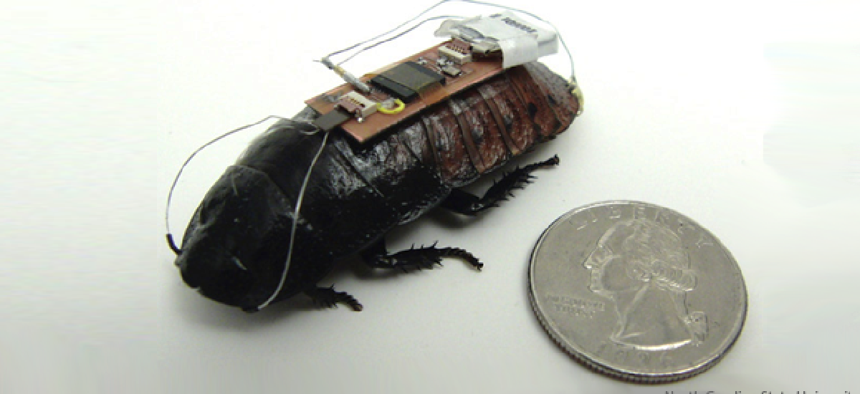Sensor-equipped cockroaches to the rescue

Biobots can be dispatched into damaged buildings or other hazardous environments to collect data.
If you’re trapped in a building after, say, an earthquake, consider yourself lucky if you see a herd of cockroaches headed your way -- if they’ve been sent in and are being controlled by first responders, that is.
A team at North Carolina State University is working on attaching tiny, sensor-laden circuit boards to the backs of roaches.
According to Edgar Lobaton, an assistant professor of electrical and computer engineering at NCSU and a member of the research team, the circuit board “backpack” also has an RF transmitter and electrodes that are connected to the antennae and abdomen of the cockroach. “We send a pulse and the cockroach responds based on that,” he said.
The result is what the researchers call “biobots” that can be dispatched into damaged buildings or other hazardous environments to collect data. The researchers have also developed software to follow the paths of the insects so that first responders can construct a map of the interior of the building.
And while individual cockroaches can be directed by signals sent to attached electrodes, the insects are “corralled” by a cowboy drone equipped with a proximity beacon that accesses the transmitter to keep the herd of cockroaches on track.
The system has already been tested using small, 1.5 inch robots that mimic cockroach behavior. The next step, Lobaton said, will be to use real bugs.
Which raises an obvious question: What’s the advantage of using cockroaches instead of tiny robots?
The primary advantage, Lobaton said, is that cockroaches move better than currently available robots. “Cockroaches are very mobile and agile,” he said. “They have behaviors that are engraved in the insects through evolution, such as going out and exploring the environment to look for food. We are trying to take advantage of that.”
The system, Lobaton said, would be impractical if they tried to control every movement of the insects. Too much controlling, he said, “is not very economical in terms of energy consumption.”
When cockroach cowboys need to redirect a one of the herd, however, they can send signals to do so. “We’re not really controlling each one of their limbs all of the time, he said, “but we can send a signal to do a right turn or a left turn, move forward or stop.”
The team is also looking at using other types of sensors with the biobots, such as microphones, Lobaton said. “The scenario that we often have in mind is some sort of search-and-rescue operation,” he said. “You need to know exactly where people are located.” The tiny microphones would allow first responders to detect a victim’s location from cries for help.
Lobaton said other sensors -- such as chemical sensors or radiation sensors -- could also be deployed on the backpack, depending on the nature of the hazards present.
NEXT STORY: How DUIx gets cutting-edge tech so quickly





